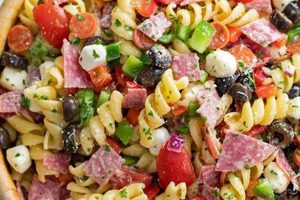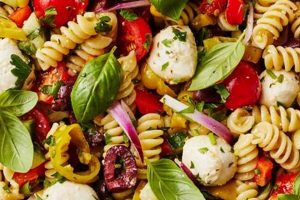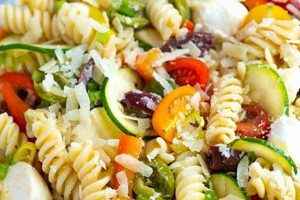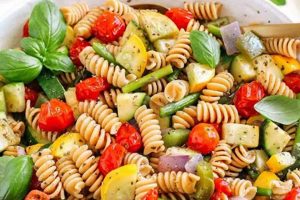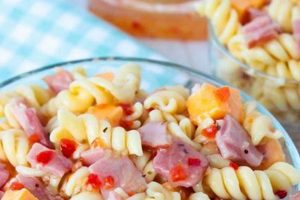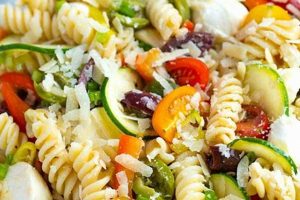Dishes featuring chilled pasta combined with various ingredients, bound by a rich, emulsified dressing, represent a popular culinary category. These dishes often incorporate vegetables, proteins, cheeses, and herbs, offering versatility and adaptability to diverse palates and dietary preferences. A classic example includes cooked rotini pasta tossed with mayonnaise, celery, onion, and hard-boiled eggs.
The appeal of these chilled pasta dishes lies in their refreshing nature, making them ideal for warm weather or light meals. Their adaptable nature allows for creative ingredient combinations, catering to specific dietary needs, such as vegetarian, vegan, or gluten-free. Furthermore, they are often prepared in advance, making them convenient for picnics, potlucks, and other social gatherings. Historically, cold pasta dishes have evolved from simple preparations to more complex and flavorful combinations reflecting regional and cultural influences.
This discussion will further explore variations on this culinary theme, covering topics such as ingredient selection, dressing preparation, and tips for achieving optimal flavor and texture. Specific recipes will be highlighted, showcasing the diversity and adaptability of this popular food category.
Tips for Creating Exceptional Chilled Pasta Salads with Creamy Dressings
Achieving a well-balanced and flavorful chilled pasta salad requires attention to detail and a thoughtful approach to ingredient selection and preparation. The following tips offer guidance for creating exceptional dishes.
Tip 1: Pasta Selection and Cooking: Opt for short, sturdy pasta shapes that hold their shape well and readily absorb the dressing. Cook pasta al dente to maintain texture and prevent a mushy salad. Rinse cooked pasta under cold water to stop the cooking process and enhance its firmness.
Tip 2: Dressing Emulsification: A stable emulsion ensures a creamy, cohesive dressing. Utilize high-quality mayonnaise or a combination of mayonnaise and other emulsifying agents like sour cream or Greek yogurt. Whisk the dressing ingredients thoroughly to achieve a smooth, uniform consistency.
Tip 3: Ingredient Balance and Flavor Profiles: Strive for a balance of flavors and textures. Incorporate a variety of vegetables, proteins, and cheeses to create complexity. Consider complementary flavor profiles, such as pairing salty ingredients with sweet or acidic elements.
Tip 4: Fresh Herbs and Seasoning: Fresh herbs elevate the flavor profile of the salad. Incorporate chopped herbs like dill, parsley, chives, or basil. Season generously with salt, pepper, and other spices to enhance the overall taste.
Tip 5: Chilling and Serving: Allow the salad to chill thoroughly in the refrigerator for at least 30 minutes before serving. This allows the flavors to meld and enhances the refreshing quality of the dish. Serve chilled for optimal enjoyment.
Tip 6: Ingredient Preparation: Ensure vegetables are appropriately chopped and prepared. Blanch or roast certain vegetables to enhance their flavor and texture before adding them to the salad. Use high-quality, fresh ingredients whenever possible.
Tip 7: Avoiding Excess Moisture: Remove excess moisture from ingredients, such as tomatoes or cucumbers, before adding them to the salad. This prevents the dressing from becoming watery and helps maintain the desired texture.
By following these tips, one can consistently produce delicious and visually appealing chilled pasta salads with creamy dressings suitable for various occasions.
This information provides a solid foundation for crafting delightful pasta salads. The following section will present specific recipe examples to further illustrate the principles discussed.
1. Creamy Dressing Base
The creamy dressing base serves as the defining characteristic of pasta salads described as “creamy.” It provides the essential textural element that binds the other ingredients and contributes significantly to the overall flavor profile. The dressing’s consistency, typically achieved through emulsification, coats the pasta and other components, creating a cohesive and palatable dish. Without a creamy dressing, the salad would lack the characteristic richness and smooth mouthfeel. For example, a classic creamy pasta salad relies on a mayonnaise-based dressing, often enhanced with sour cream or yogurt, to deliver its signature creaminess. A vinaigrette-based dressing, while suitable for pasta salad, would result in a distinctly different, non-creamy final product.
The choice of creamy dressing base influences not only the texture but also the flavor profile of the pasta salad. Mayonnaise offers a tangy, slightly acidic backdrop, while sour cream contributes a richer, more lactic note. Greek yogurt provides a lighter, tangier alternative. These base ingredients can be further customized with herbs, spices, and other flavoring agents to complement the chosen vegetables, proteins, and pasta shapes. For instance, a creamy dressing featuring dill, lemon juice, and black pepper pairs well with salmon and cucumber, whereas a dressing based on pesto complements sun-dried tomatoes and artichoke hearts. Understanding the interplay between the creamy dressing base and other ingredients is crucial for achieving a balanced and flavorful outcome.
In conclusion, the creamy dressing base plays a pivotal role in defining the character of a creamy pasta salad. Its importance extends beyond mere texture, influencing flavor, ingredient compatibility, and overall culinary experience. Careful consideration of the dressing’s composition and its interaction with other components is essential for creating a successful and satisfying dish. Challenges may arise in achieving a stable emulsion or balancing richness with freshness; however, awareness of these factors empowers culinary exploration and facilitates the development of innovative and delicious creamy pasta salads.
2. High-quality Pasta
High-quality pasta serves as a crucial foundation for successful creamy pasta salads. The pasta’s structural integrity, ability to absorb flavors, and overall textural contribution significantly influence the final dish’s quality. Selecting appropriate pasta shapes and ensuring proper cooking techniques are essential steps in creating a satisfying culinary experience.
- Pasta Shape and Structure:
Different pasta shapes offer varying textural experiences and interact differently with creamy dressings. Robust shapes like rotini, fusilli, or farfalle hold their shape well, preventing a mushy texture and providing ample surface area for the dressing to cling to. Conversely, delicate shapes like angel hair or capellini may become limp and clump together in a creamy dressing. The choice of pasta shape should complement the other ingredients and contribute to the desired overall texture of the salad.
- Cooking Technique:
Properly cooked pasta is essential for achieving the desired texture in a creamy pasta salad. Overcooked pasta becomes mushy and absorbs too much dressing, leading to a heavy, unbalanced dish. Undercooked pasta, on the other hand, presents a hard, unpleasant texture. Cooking pasta “al dente,” meaning “to the tooth” in Italian, ensures a firm yet tender bite that holds up well in the salad. Rinsing the cooked pasta under cold water stops the cooking process and further firms the pasta, preventing it from sticking together and creating a more refreshing salad.
- Flavor Absorption:
While pasta itself has a relatively neutral flavor, high-quality pasta made from durum wheat offers a subtle nuttiness that enhances the overall flavor profile of the salad. Moreover, the pasta’s ability to absorb the flavors of the creamy dressing and other ingredients is crucial. Properly cooked pasta absorbs the dressing without becoming soggy, allowing the flavors to meld and create a cohesive taste experience.
- Visual Appeal:
The visual appeal of a pasta salad contributes significantly to its overall enjoyment. High-quality pasta maintains its shape and color, creating a visually appealing dish. The pasta’s appearance, combined with the vibrant colors of fresh vegetables and other ingredients, enhances the sensory experience of the salad. Dull, overcooked, or broken pasta detracts from the visual presentation.
By carefully considering these factors, one can select and prepare high-quality pasta that complements the creamy dressing and other ingredients, ultimately contributing to a more satisfying and enjoyable pasta salad experience. The interplay between pasta quality, cooking technique, and ingredient selection ultimately determines the success of the dish. Ignoring these elements can result in a subpar salad lacking in texture, flavor, and visual appeal.
3. Fresh, Crisp Vegetables
Fresh, crisp vegetables play a vital role in creamy pasta salads, contributing not only essential nutrients and vibrant color but also textural contrast and nuanced flavors. Their presence elevates the salad from a simple carbohydrate-heavy dish to a more complex and balanced culinary experience. Understanding the selection, preparation, and incorporation of these vegetables is crucial for maximizing their impact within the context of creamy pasta salads.
- Textural Contrast:
The crispness of fresh vegetables provides a counterpoint to the softness of cooked pasta and the richness of the creamy dressing. This contrast in textures creates a more dynamic and engaging mouthfeel, preventing the salad from becoming monotonous. Examples include the crunch of celery, the snap of bell peppers, or the juiciness of cherry tomatoes, all of which contribute distinct textural elements that enhance the overall sensory experience.
- Flavor Enhancement:
Fresh vegetables introduce a variety of flavors that complement and balance the richness of the creamy dressing. The inherent sweetness of carrots, the slight bitterness of cucumbers, or the peppery bite of radishes add depth and complexity to the overall flavor profile. These nuanced flavors prevent the salad from being overly rich or one-dimensional, creating a more harmonious and satisfying taste.
- Nutritional Value:
Incorporating fresh vegetables significantly increases the nutritional value of creamy pasta salads. These vegetables provide essential vitamins, minerals, and dietary fiber, transforming the dish into a more wholesome and balanced meal option. The addition of nutrient-rich vegetables like broccoli, spinach, or snap peas enhances the salad’s health benefits without compromising flavor or texture.
- Visual Appeal:
The vibrant colors of fresh vegetables enhance the visual appeal of creamy pasta salads, making them more appetizing and inviting. The bright reds of tomatoes, the deep greens of spinach, or the vibrant yellows of bell peppers create a visually stimulating dish that complements the creamy white backdrop of the dressing. This visual appeal contributes to a more enjoyable dining experience.
The strategic incorporation of fresh, crisp vegetables is essential for creating well-rounded and appealing creamy pasta salads. Their contribution extends beyond mere aesthetics, impacting texture, flavor, and nutritional value. Achieving a balance between the creamy richness of the dressing and the fresh vibrancy of the vegetables is key to crafting a successful and satisfying dish. Consideration should be given to the compatibility of flavors and textures, ensuring a harmonious blend of ingredients that elevates the pasta salad beyond a simple side dish to a culinary centerpiece.
4. Complementary Protein Additions
Protein additions play a crucial role in enhancing creamy pasta salads, transforming them from side dishes into more substantial and satisfying meals. These additions contribute not only nutritional value but also textural and flavor complexity, creating a more balanced and enjoyable culinary experience. The strategic selection and incorporation of complementary proteins are essential for maximizing their impact within the overall composition of the salad.
- Nutritional Enhancement:
Protein enriches pasta salads with essential amino acids, contributing to satiety and providing sustained energy. This addition transforms the dish into a more complete and balanced meal, particularly beneficial for those seeking a lighter yet fulfilling option. Incorporating proteins like grilled chicken, salmon, or beans elevates the nutritional profile of the salad, making it a more wholesome choice.
- Textural Diversity:
Proteins introduce textural variations that complement the creamy dressing and other ingredients. The tender flakes of cooked chicken, the firm bite of chickpeas, or the delicate texture of flaked tuna create contrasting mouthfeels that enhance the overall sensory experience. This interplay of textures prevents the salad from becoming monotonous, adding depth and complexity to each bite.
- Flavor Complexity:
Complementary proteins contribute diverse flavors that enhance the overall flavor profile of the salad. The savory notes of grilled chicken, the smoky flavor of salmon, or the earthy taste of lentils add depth and complexity to the creamy base. Careful consideration of flavor pairings ensures a harmonious balance between the protein, the dressing, and other ingredients, creating a more nuanced and satisfying taste.
- Versatility and Adaptability:
The versatility of protein additions allows for customization and adaptation to various dietary preferences and culinary styles. Vegetarian options like beans, lentils, or tofu provide plant-based protein sources, while meat-based options like chicken, ham, or shrimp cater to different palates. This adaptability ensures that creamy pasta salads can be tailored to individual needs and preferences, expanding their appeal and versatility.
The inclusion of complementary proteins elevates creamy pasta salads from simple sides to more substantial and satisfying meals. By carefully considering the nutritional, textural, and flavor contributions of various protein options, one can create well-balanced and flavorful dishes that cater to a range of dietary preferences and culinary styles. The interplay between the creamy dressing, the fresh vegetables, the pasta, and the chosen protein ultimately determines the overall success and enjoyment of the salad.
5. Flavorful Herbs and Spices
Flavorful herbs and spices contribute significantly to the complexity and overall enjoyment of creamy pasta salads. They provide depth and nuance, balancing the richness of the creamy dressing and complementing the other ingredients. Their careful selection and application can elevate a simple pasta salad to a more sophisticated and flavorful dish. The interplay between herbs, spices, and the creamy base creates a synergistic effect, enhancing the overall sensory experience.
Specific herbs and spices offer distinct flavor profiles that can be strategically employed to achieve desired outcomes. For instance, dill, parsley, and chives impart fresh, bright notes that cut through the richness of mayonnaise-based dressings. Basil and oregano contribute a more robust, Mediterranean character, while mint adds a refreshing coolness. Spices like paprika, cayenne pepper, or black pepper introduce warmth and subtle heat, further enhancing the complexity of the flavor profile. The choice of herbs and spices should complement the other ingredients, such as vegetables and proteins, creating a harmonious and balanced flavor composition. A creamy pasta salad featuring salmon and cucumber benefits from the addition of dill and lemon zest, whereas a salad with roasted vegetables and feta cheese might be enhanced by oregano and a touch of smoked paprika. Understanding these flavor pairings allows for a more deliberate and nuanced approach to recipe development.
In conclusion, the judicious use of flavorful herbs and spices is essential for crafting exceptional creamy pasta salads. They provide depth, complexity, and balance, elevating the dish beyond its basic components. Careful consideration of flavor pairings and the interplay between herbs, spices, and the creamy base allows for the creation of truly memorable and satisfying culinary experiences. Challenges may arise in balancing the intensity of certain herbs and spices, but thoughtful experimentation and attention to detail ultimately lead to the discovery of unique and delightful flavor combinations.
6. Proper Chilling Time
Proper chilling time is a crucial element in achieving optimal flavor and texture in creamy pasta salads. Chilling allows the flavors of the various ingredients, including the creamy dressing, vegetables, proteins, and herbs, to meld and harmonize. Furthermore, chilling firms the pasta and enhances the refreshing quality of the salad, making it particularly appealing in warmer weather. Insufficient chilling can result in a bland, less cohesive dish, while excessive chilling may negatively impact the texture of certain ingredients.
- Flavor Development:
Chilling allows the diverse flavors within the salad to meld and mature. The creamy dressing absorbs the flavors of the vegetables, herbs, and proteins, creating a more complex and nuanced flavor profile. This process of flavor integration is essential for achieving a well-balanced and harmonious taste experience. For instance, the subtle sweetness of roasted vegetables can permeate the dressing, while the savory notes of grilled chicken can become more pronounced after a period of chilling.
- Texture Enhancement:
Chilling firms the pasta and other ingredients, improving the overall texture of the salad. The cold temperature solidifies the fats in the creamy dressing, creating a more stable emulsion and a smoother, more cohesive texture. Additionally, chilling can enhance the crispness of certain vegetables, providing a pleasant textural contrast to the creamy dressing and tender pasta. Conversely, over-chilling can make some vegetables, like tomatoes, lose their texture and become watery.
- Temperature and Palatability:
Serving creamy pasta salad chilled enhances its refreshing quality, making it particularly appealing during warm weather or as a light meal option. The cool temperature provides a welcome contrast to the richness of the creamy dressing, making the salad more palatable and enjoyable. A warm or room-temperature creamy pasta salad can feel heavy and less refreshing.
- Food Safety:
Proper chilling is essential for maintaining food safety, particularly with creamy pasta salads containing mayonnaise or other perishable ingredients. Chilling inhibits the growth of harmful bacteria, reducing the risk of foodborne illness. Maintaining a consistent cold temperature below 40F (4C) is crucial for ensuring food safety and preventing spoilage.
In conclusion, proper chilling time is an essential step in creating successful creamy pasta salads. It contributes significantly to flavor development, texture enhancement, and overall palatability. By understanding the impact of chilling on the various components of the salad, one can optimize the chilling process to achieve the desired outcome. Neglecting proper chilling can compromise the flavor, texture, and safety of the dish, diminishing the overall culinary experience.
7. Balanced Flavor Profiles
Balanced flavor profiles are essential for successful creamy pasta salads. The richness of the creamy dressing, often mayonnaise-based, necessitates a careful balance of contrasting and complementary flavors to prevent the dish from becoming overly rich or one-dimensional. This balance is achieved through the strategic incorporation of acidic, sweet, salty, and savory elements. The creamy dressing provides a blank canvas upon which these flavors can interact and harmonize. For instance, the tanginess of vinegar or lemon juice cuts through the richness of the mayonnaise, while the sweetness of sun-dried tomatoes or roasted red peppers adds depth. Salty elements, such as olives, capers, or feta cheese, provide a savory counterpoint, and the addition of fresh herbs like dill or parsley introduces bright, herbaceous notes. A well-balanced creamy pasta salad exhibits a harmonious interplay of these flavors, creating a complex and satisfying taste experience. Without this balance, the salad can become cloying or bland, lacking the dynamic interplay of contrasting tastes.
The practical significance of understanding flavor balance in creamy pasta salads lies in the ability to create dishes that are both enjoyable and nuanced. Consider a classic creamy pasta salad with rotini, celery, onion, and hard-boiled eggs. The mayonnaise-based dressing provides the creamy richness, while the celery and onion offer a subtle vegetal sweetness and crunch. The hard-boiled eggs contribute a savory element, and the addition of a touch of mustard or vinegar introduces a necessary acidic counterpoint. This interplay of flavors creates a balanced and satisfying profile. However, if the salad lacked the acidic element, the richness of the mayonnaise could become overwhelming. Conversely, an overabundance of acidic ingredients could make the salad too tart. Understanding these dynamics allows for precise adjustments and the creation of custom flavor profiles tailored to individual preferences.
In conclusion, achieving a balanced flavor profile is paramount in creating successful creamy pasta salads. The interplay of creamy, acidic, sweet, salty, and savory elements creates a dynamic and harmonious taste experience. Practical application of this understanding enables the development of recipes that are not only delicious but also demonstrate a nuanced appreciation for flavor composition. Challenges in balancing these elements can arise, particularly when incorporating strongly flavored ingredients; however, careful consideration and experimentation with different flavor combinations allow for the creation of unique and satisfying creamy pasta salads.
Frequently Asked Questions
This section addresses common inquiries regarding the preparation and enjoyment of creamy pasta salads.
Question 1: What pasta shapes are best suited for creamy pasta salads?
Sturdy shapes like rotini, fusilli, farfalle, and penne hold their shape well and readily capture the dressing. Avoid long, thin pasta like spaghetti or angel hair, which can become limp and clump together.
Question 2: How can one prevent a creamy pasta salad from becoming watery?
Excess moisture from vegetables can dilute the dressing. Thoroughly dry vegetables after washing, and consider salting and draining watery vegetables like cucumbers or tomatoes before adding them to the salad.
Question 3: What are some alternatives to mayonnaise for a creamy dressing base?
Greek yogurt, sour cream, or a combination of these with mayonnaise offer lighter alternatives while maintaining creaminess. Avocado can also be blended into a dressing for a vegan option.
Question 4: How long can creamy pasta salad be stored safely?
Refrigerate promptly and store in an airtight container for up to 3-5 days. Discard any salad left at room temperature for more than two hours.
Question 5: How can one enhance the flavor of a creamy pasta salad beyond the dressing?
Incorporating fresh herbs, spices, zests, and flavorful add-ins like olives, capers, or roasted vegetables adds depth and complexity to the overall flavor profile.
Question 6: Can creamy pasta salad be frozen?
Freezing is not recommended. Mayonnaise-based dressings can separate upon thawing, and the texture of vegetables often deteriorates. Freezing pasta can also result in a mushy texture upon thawing.
Understanding these common points of concern allows for a more successful and enjoyable creamy pasta salad preparation experience. Addressing potential issues proactively ensures a delicious and satisfying final product.
This FAQ section concludes the discussion on creating exceptional creamy pasta salads. The knowledge gained from these insights empowers culinary exploration and encourages the development of customized and delicious recipes.
Creamy Pasta Salad Recipes
Exploration of creamy pasta salad recipes reveals the multifaceted nature of this culinary category. Careful consideration of pasta shape, dressing composition, ingredient selection, and chilling time contributes significantly to the overall quality and enjoyment of the dish. Balancing creamy richness with contrasting flavors and textures is essential for achieving a harmonious and satisfying culinary experience. High-quality ingredients, proper cooking techniques, and attention to detail elevate creamy pasta salads from simple side dishes to culinary centerpieces.
The versatility of creamy pasta salads allows for endless variations and adaptations, catering to diverse palates and dietary preferences. Continued exploration of flavor combinations, ingredient pairings, and innovative dressing formulations promises further evolution within this culinary domain. Mastering the fundamental principles of balance, texture, and flavor empowers culinary creativity and ensures consistently delicious and satisfying results.

